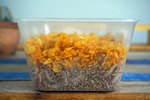
Bugs enjoy eating a variety of organic materials, including cardboard, which is why you'll likely find them gnawing on your cardboard boxes in spaces like attics, garages and basements. Because cardboard is made from wood or natural fabrics and glue, it makes an excellent source of food for various types of insects, many of which you'll usually find right in and around your home.
Rambunctious Roaches
One of the most common types of insects who eat cardboard is the roach. Cockroaches, including the German, Oriental, American and brown-banded species, all enjoy nibbling on cardboard boxes, books and pictures in your home. They also like living on porous materials like cardboard because they can saturate them with their own scent secretions, according to the University of Nebraska Cooperative Extension in Lancaster County. These secretions attract other cockroaches to the area because these insects tend to live in groups. Roaches can carry germs and trigger allergic reactions or asthma in people, so they aren't desirable to have in your home.
Sly Silverfish
Like cockroaches, silverfish prefer to live in warm, humid spaces in your home. They enjoy eating starchy paper products and glue, both components of cardboard. These small bugs are around three-quarters of an inch in length and silver to brown in color, with bodies covered in scales, according to the Texas A&M AgriLife Extension. Silverfish are most active at night and aren't harmful to people, although their diet may cause damage to your storage boxes and books, as may their waste.
Terrible Termites
Termites are well known for dining on wood products, including cardboard. These insects eat wood-based materials to ingest the cellulose that the wood contains. A telltale sign of termites eating cardboard boxes or other wood-based materials in your home is a sandy, gritty residue left in their path of destruction, warns the Albuquerque Journal. Termites can hitch a ride into your home in cardboard boxes and quickly infest your walls, devouring your drywall, plastic materials and even thin sheets of lead, according to the Louisiana State University College of Agriculture.
Crafty Crickets
Crickets are known for the chirping sound that the male makes as part of his ritual to find a mate. These bugs, sometimes kept as pets, also enjoy nibbling on cardboard and shouldn't be kept in containers made from this material because they'll quickly gnaw their way through it to escape into your home. You can line their habitats with cardboard, though, to give them a soft, porous surface to walk on, because their feet can't hold on to smooth surfaces.
Outsmarting the Hungry Bugs
Other insects, like woodboring, drugstore, larder, hide or carpet beetles, along with clothes moths and booklice, might occasionally nibble on cardboard in your home, according to the Bernice Pauahi Bishop Museum website. To prevent any bugs from dining on cardboard within your abode, keep books in sealed plastic bags or within plastic containers. Get rid of cardboard boxes and vacuum your home regularly. Without any cardboard around to eat, many common household insects won't have any reason to become unwelcome houseguests.
References
- Bernice Pauahi Bishop Museum: "Bugs" are Eating My Family Treasures! [PDF]
- Louisiana State University College of Agriculture: What Do Termites Eat?
- University of Nebraska Cooperative Extension in Lancaster County: Least Toxic Cockroach Control
- Full Option Science System (FOSSWEB): Crickets
- Albuquerque Journal: Termites Likely Ate Cardboard Boxes, Made Mess
- Business Insider: You'd Be Surprised How Complicated It Is to Manufacture Cardboard Boxes
Resources
Photo Credits
-
Hemera Technologies/PhotoObjects.net/Getty Images
Writer Bio
Based in Las Vegas, Susan Paretts has been writing since 1998. She writes about many subjects including pets, finances, crafts, food, home improvement, shopping and going green. Her articles, short stories and reviews have appeared on City National Bank's website and on The Noseprint. Paretts holds a Master of Professional Writing from the University of Southern California.




